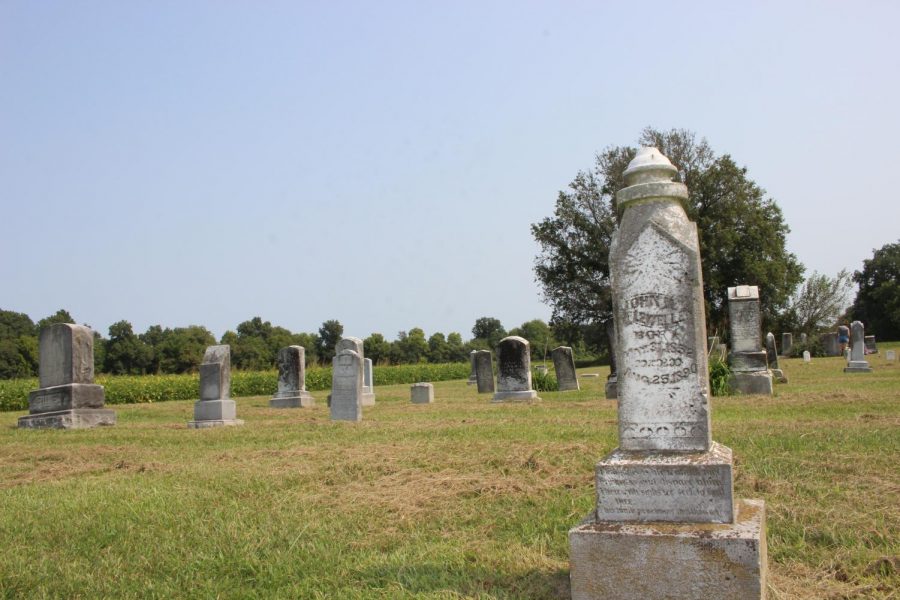Exploring extinction
Abandoned towns features radiation, abandonment and the deceased
Georgia City cemetery is a perfect place for October frights.
October 2, 2020
Ghost towns, deserted fields or plains left to shrivel in the past yesterday. Revolving to serve no more, the buildings of man made creations slowly sink in the sun. Bricks and stones covered in moss can be a spooky photo shoot or fun place to explore.
Times Beach
Missouri is home to ghost towns scattered across the 68,886 square miles of land that make up the state. Times Beach was established in 1925 with a lifespan of 57 years before the town was evacuated in the early 1980s and later bulldozed in 1991. Located 17 miles southwest of St. Louis, this small town was home to the land of purple oil that was layered on the street. The oil was hexachlorophene mixed with dioxin, a radioactive and deadly mix. This oil was made to help keep dust down on the gravel roads, but it left hazardous waste.
Animals, such as cattle and horses, dropped dead. The United States Environmental Protection Agency came to Times Beach in 1979 to collect samples of the soil. By 1982, they released the information that the toxin in charge of the animals dropping was a cancer-causing agent.
The citizens of Times Beach abandoned town just after Christmas that year and it now lays as a tourist destination for those who take route sixty six. The radiation and toxins have been cleaned up and buried.
Plano
Another ghost town in Missouri, much closer to Nixa, is Plano. Plano, unlike Times Beach, was not evacuated; instead it was left to history because of the development of Route 66. The drive to Plano lays along a farm road with other broken down buildings not a part of the town itself. Plano is marked at a cross in the roads with a brown historic sign signaling to the building across the street.
A general merchandise store that was also the town’s grocery store was built out of limestone by the Jackson family, the first level being the store with the second level being the home space for the residence.
The old store now without a floor, ceiling, top to the building, doors, or windows is a hand made wonder. Arches, place holders for the no longer existing windows, still hold up today. Upon looking at the left side of the building you can see a star-like metal appendage with unknown uses and a crack splitting down mid-center of the limestone surface. Pieces of wood are jammed in random places along archways, surprisingly having not yet rotted under weather conditions.
Greenery surrounds the decaying ruins inside and out. While it is mostly vines creeping over top of walls, the inside of the building is packed with tall trees, thorn bushes, ferns, ect
Though if one does wish to travel to this gem, caution should be used. Trouble surrounds the building on all sides. One the left side of the building a busy road lays within two feet only to wrap around the front of the building as well. On the right just 10 feet of the historic site is a small powerbox attached on a pole separate pole that connects to the electric lines.
Nothing is more dangerous than the building itself. With splitting of walls and thorn bushes growing inside the decaying structure. It is also home to many animals, with a black widow spider sometimes waiting on the wall.
The hand-slabbed bricked windows of the first floor are relatively low to the ground and still have enough depth and height for sitting or standing pictures shots.
Not all ghost towns have buildings left to speak for them. Nor should all ghost towns be seen as a place to explore or have fun photo shoots in; instead they should be treated with respect. Because not only would it be insensitive to do such tom foolery, but it could upset the laid to rest.
Georgia City
Twenty minutes from Joplin, the only remains of a ghost town is a cemetery. Not much is known about the old town of Georgia City. Established more than 100 years ago in 1868, the town lasted for 62 years before being declared a ghost town in the 1930s during the Great Depression.
The Georgia City cemetery resigns just at the merging of Pine Rd. as it turns to Farm Rd. 270 in the town of Belleville. The graveyard is surrounded by open fields. The small gravel parking lot at the resting sight is big enough for three cars, though make sure to park away from the 8-foot limbless tree that looks as though it will fall over any second. Down 270 is a farmhouse about a mile from the yard. The front of the burial sight is marked as a Georgia City metal sign sticks up from the ground to welcome travelers.
The oldest in the burial sight that was most legible, compared to older ones that had given way to erosion, did not even receive a name. Instead it was labeled “Wife of Mys Bane” who died in 1885.
Resting on the front of a handful of the 40-plus graves were symbols such as a single rose, hands shaking, a dog, and an unknown engraving all presuming to be family crests distinguishing who was family. Though some more recent headstones did not have a family crest and looked structurally new compared with modern-day graves.
The layout of graves was interesting as well, while some were scattered a further distance away, or almost molding to a tree. Others were perfectly spaced, all in line, and sometimes five times the size compared to other tombstones. Though the most notable thing about the graveyard was that the grass was still short which is either maintained by local citizens out of respect or the ground keeps being held up by Jasper County.
The recommendation
Out of all of the places I visited, Plano was the best. While a bit hazardous, it is undeniably alluring. The ornate hand-laid stone gives off a cozy yet dark academia aesthetic. It’s complemented by the vines, trees and bushes that crawl along the textured walls. While more hazardous than other places, it still maintains a safe environment. Even though it’s a ghost town, people live close enough to not be worried about going alone. It is to be assumed that during the winter, the leaves would be long gone along with all once vibrant life. This would allow better exploration for the inside of the building. But caution should still be used as the previously mentioned hazards will still be present.






